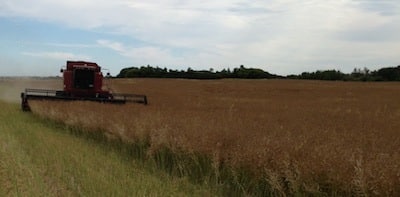Stick to your game plan. If you grew a pod shatter tolerant variety, straight cutting assessments are potentially not as critical. Sticking to the plan may be the best bet. If you have been considering straight cutting a non-shatter tolerant variety, be sure to assess the crop for suitability prior to swath timing so you can potentially switch plans in time to swath. Read more.
Knitted crop. The crop should be well knitted and slightly lodged to reduce potential seed loss through shelling and pod drop. If a large proportion of the plants appear to move independently in the wind, they will be at higher risk for shattering loss as the plants senesce and dry down.
Pod integrity. If a lot of pods have been damaged by disease, frost, drought, hail or insect damage, this may not be a good candidate field for straight combining. Hail will typically cause more damage to a standing crop than a swathed crop.
Uniform growth stage. A uniform crop with all plants drying down at the same rate makes straight combining easier to time. This can sometimes be most related to field topography, with the lower areas holding onto more moisture than the top of slopes.
Minimal green weed growth. Weeds will stay green longer, and make straight combining much more onerous on the combine. Green weed seed will also end up in the hopper, and with a moisture content at least 3% higher than your canola, these green weed seeds can increase storage risk.
Low frost risk. Canola seed is at significant risk for fall frost damage until seed moisture drops below 20%. This moisture drop will take much longer in a standing crop, and as such, late maturing crops may be poor candidates for straight cutting if there is significant risk for a fall frost.
Swathing may be preferred over straight combining when the crop is:
—Immature with an elevated frost risk
—Uneven with regard to staging
—Heavy with green weed growth or crop re-growth
—At a high risk for pod drop and shatter
Additional considerations that may reduce the risk of straight combining:
—Short, severely lodged, or excessively branched canopies may be candidates for straight combining because if swathed there would be small windrows and minimal stubble left to anchor them in high winds. In this situation growers should consider the potential for wind damage to the swath relative to shattering risk if left standing.
—The grower has appropriate combine equipment for straight combining, and some operator experience.
—The crop is a variety with increased shattering tolerance and lodging resistance.
Further reading:
Country Guide article with new research: Comfort builds for straight-combining canola
Top 10 tips for lower straight combining risk
Straight combining thin crops
Best headers for straight combining canola
Pre-harvest products for use in canola
Canola Encyclopedia: Swathing vs straight combining
September 2013 Canola Digest with cover article on straight combining canola

